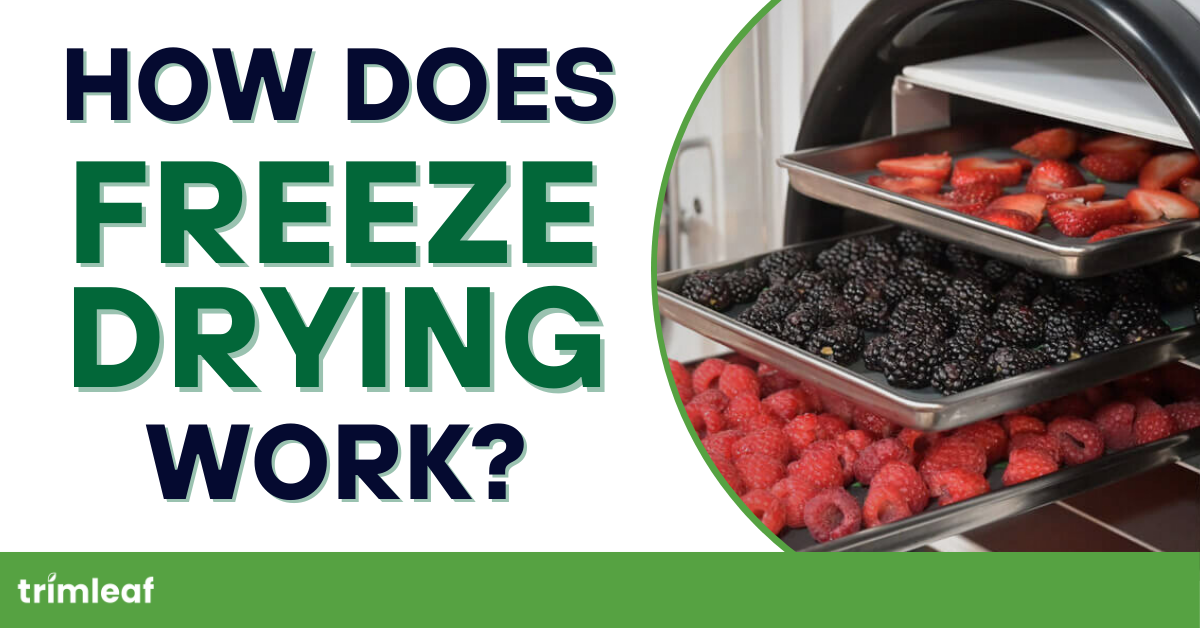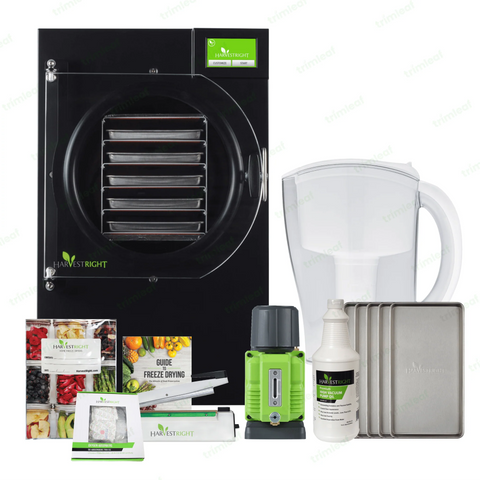

Well, with today’s technology and advancements in science, long-term food preservation without additives is possible with freeze-drying.
Freeze drying, sometimes also known as lyophilization, works by freezing the food at low temperatures and then subjecting it to a vacuum that removes the ice crystals formed during the freezing process. This allows the moisture to evaporate directly from solid ice to gas without passing through the liquid phase, preserving the food's shape, color, and flavor.
Unlike traditional preservation methods that often involve heat or chemical additives, freeze-drying gently removes moisture, significantly retaining the product's nutritional content and extending its shelf life.
Table of Contents
The Freeze Drying Process

Freeze drying involves three key phases: freezing, primary drying, and secondary drying. Each phase is crucial in preserving the product's quality, texture, and stability, ultimately producing a high-quality preserved product with extended shelf life and minimal moisture content.
Understanding each phase is essential for mastering the freeze-drying process and achieving optimal results.
Phase 1: Deep Freezing
Deep freezing is a critical step in freeze-drying as it sets the stage for successful preservation. By lowering the temperature of the product to well below freezing, typically around -40 degrees Celsius or lower, deep freezing ensures that water molecules within the product solidify uniformly.
This uniform freezing minimizes the formation of large ice crystals, which can damage the product's cellular structure and lead to loss of texture and quality. Rapidly freezing the food is essential for achieving small ice crystal formation and preserving the product's texture and appearance.
This prevents the formation of large ice crystals by minimizing the time available for water molecules to migrate and form bonds. As a result, the product retains its original texture and appearance after the freeze-drying process, ensuring a visually appealing and palatable final product.
Phase 2: Primary Drying
Primary drying, or sublimation, is where frozen water molecules transition directly from a solid state to a vapor state under reduced pressure. This process occurs in a vacuum chamber, where the pressure is lowered to create an environment ideal to sublimation.
A vacuum pump removes air and reduces the pressure within the chamber. The frozen product is heated gently during the primary drying, causing the ice to sublimate and transform into water vapor.
The vapor is removed from the chamber, leaving behind a freeze-dried product with reduced moisture content. The condenser plays a crucial role in this phase by collecting the water vapor released during sublimation, preventing it from recondensing on the product and ensuring efficient moisture removal.
Phase 3: Secondary Drying
Secondary drying, also known as desorption, is the final phase of the freeze-drying process and focuses on removing any remaining moisture from the product to achieve the desired level of dryness and stability.
Unlike primary drying, which primarily targets bound water molecules, secondary drying targets the removal of residual moisture that may be trapped within the product's structure.
Heat is cautiously applied during secondary drying to facilitate the removal of residual moisture while maintaining the vacuum within the chamber. This careful application of heat helps prevent damage to the product while ensuring a thorough moisture removal.
The duration of secondary drying depends on factors such as the product's composition, thickness, and desired final moisture content.
Factors That Affect Freeze Drying Time
Factors influencing drying time include the type of food being processed and its thickness. Certain foods, such as fruits and vegetables with high water content, may require longer drying than foods with lower moisture content, such as meats or dairy products.
Additionally, the thickness of the food slices or pieces can impact drying time, with thicker pieces requiring more time to dehydrate thoroughly. You need to experiment and test to determine the ideal drying time for different foods and thicknesses, allowing for adjustments and optimization of the process over time.
Benefits of Freeze-Dried Food

Freeze-dried food offers several advantages, making it an ideal food preservation choice. It offers no compromise in flavor and quality and is integrated easily into one’s diet. So what benefits can you expect when freeze drying?
✓ Easy Rehydration and Reconstitution
Whether it's fruits, vegetables, or fully prepared meals, freeze-dried products regain their original texture and flavor with just a small amount of water. This makes it convenient for emergencies, camping, and on-the-go meals.
✓ Taste and Nutritional Preservation
Unlike traditional preservation methods that can compromise the taste and nutritional value of food, freeze-drying preserves the ingredients' original flavor, texture, and nutritional integrity.
✓ Long-Term Storage and Lightweight Properties
Freeze-dried foods are compact and lightweight due to the removal of water content. Additionally, freeze-dried food boasts an impressive extended shelf life, lasting up to 25 years or longer when stored properly.
✓ Add a Twist to Existing Food
One of the latest crazes in the confectionary world is freeze-dried candy. This method allows you to add a new twist to existing sweets and make them more flavorful without significantly adding chemicals or other ingredients.
Which Foods Can Be Freeze-Dried?

This innovative preservation method makes food ultra-lightweight, storable for years, and simple to prepare, making it perfect for hikers, campers, astronauts, and anyone who wants a reliable food source in emergencies.
While fruits and vegetables are popular choices, freeze-drying can transform almost any food into a shelf-stable version. Here are some foods you can freeze dry:
- Fruits
- Grains
- Frozen Meals
- Veggies
- Sweeteners
- Meat
- Herbs and Spices
- Beverages
Potential Downsides of Freeze-Drying
While freeze-drying excels at preserving food, it has some drawbacks as well. Here are a couple of things to keep in mind:
- Hidden Bacteria — Freeze-drying removes water, making it tough for most microbes to survive. But some harmful bacteria in raw meat and eggs can survive through the process and pose a foodborne illness risk if not cooked thoroughly before eating.
- Air exposure can degrade nutrients — The spongy texture of freeze-dried food lets in more oxygen. This can speed up oxidation, potentially leading to some nutrient breakdown over time.
- Cost — Freeze dryers are expensive, and commercially freeze-dried food can be pricey.
- Time — Freeze-drying can take several hours depending on the food and quantity.
- Not suitable for all foods — Fatty foods or those with high sugar content may not freeze-dry well.
Freeze-drying is a great option for long-lasting food storage, but remember to cook raw ingredients first and be aware that some nutrient loss might occur. So, proper labeling and following cooking instructions are crucial for raw freeze-dried items.
Types of Freeze Dryers
Freeze-dryers come in various types, each suited for different applications and scales of production. Understanding the differences between industrial and home freeze dryers is essential for selecting the most appropriate option.
Home Freeze Dryers

Home freeze dryers are for small-scale operations, typically for individual or family use. These units are compact, user-friendly, and often countertop-sized, making them suitable for kitchens or small spaces. Reputable brands like Harvest Right and The Cube offer home freeze dryers.
These freeze dryers are ideal for preserving small batches of food, herbs, or other items, offering convenience and flexibility for personal use. While they may have limitations in capacity and processing speed, they are more affordable and accessible for home users.
Commercial Freeze Dryers

On the other hand, commercial freeze-dryers are designed for larger-scale operations, catering to commercial food production and other applications that require massive capacities. Their significantly larger size and higher capacity come with the need for specialized installation and expertise for operation.
Laboratory Freeze Dryers

There are also laboratory freeze dryers used in laboratories and places where the environment can affect the potency of medicines, thus requiring a freeze dryer that can help prevent spoilage.
Finally, laboratory-scale freeze dryers serve a critical role in research settings. Here, precise control and environmental factors are paramount. These freeze dryers offer a wider range of capacities, from handling small samples to accommodating medium-sized batches.
They also have features like precise temperature control and monitoring to ensure the potency of delicate materials like medicines. Additionally, many lab-grade dryers boast advanced features for data recording and process optimization. The
Harvest Right Scientific and
Holland Green Science Xiros Mikro are examples of laboratory-scale freeze dryers.
Conclusion
Freeze drying offers many possibilities for preservation. It has become the go-to for people looking to store food for the long term, prepare emergency kits, or even cure buds and dry bubble hash for consumption.
Interested in investing in a freeze dryer?
To learn more about freee-drying, checkout the following resources:
- How to Freeze Dry Food at Home
- Is Freeze-Dried Fruit Healthy? What You Need to Know
- Starting a Freeze-Drying Food Business? Here's What You Need to Know
Frequently Asked Questions About Freeze Drying
- What is freeze-drying?
- Freeze-drying, also known as lyophilization, is a drying process that involves freezing a substance and then removing the ice crystals through sublimation, resulting in a freeze-dried product with preserved properties.
- How does freeze-drying work?
- Freeze-drying works by first freezing the material, then placing it in a vacuum where water molecules sublimate, leaving a dehydrated product with an extended shelf life.
- How do freeze dryers work?
- Freeze dryers work by lowering the pressure to cause sublimation of the frozen water in the material, followed by a secondary drying phase to remove any remaining moisture.
- How does freeze-drying help preserve food?
- Freeze-drying helps preserve food by removing water content without affecting the nutritional value, texture, or taste of the food material.
- Does freeze-drying kill bacteria?
- No, freeze-drying itself does not kill bacteria. However, the low moisture content inhibits bacterial growth significantly. Raw meat or eggs should be cooked thoroughly before freeze-drying to eliminate any potential risks.
- Does freeze-dried food retain all its nutrients?
- Freeze-drying is considered one of the best methods for preserving food's nutritional value. Most vitamins and minerals remain intact compared to other preservation methods like canning or dehydrating.
- How do you rehydrate freeze-dried food?
- Simply add clean water to the freeze-dried food and let it sit for a recommended time, usually a few minutes to an hour depending on the food.
- Can you freeze-dry food at home?
- Yes, there are small home freeze dryers available, but they are typically expensive and have limited capacity compared to commercial models.
- Where can you buy freeze-dried food?
- Freeze-dried food is becoming increasingly popular and can be found in camping stores, outdoor gear retailers, and some grocery stores. You can also find online retailers specializing in freeze-dried food.
- Why are large ice crystals undesirable in freeze-drying?
- Large ice crystals can damage the structure of the dehydrated product during sublimation. This can lead to a spongy texture and potentially slower rehydration times.




